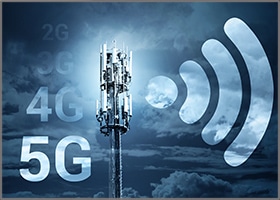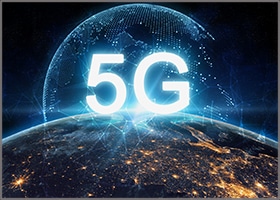
Over the last century, technology has evolved at a faster pace than any other time in human history. One smartphone holds more processing power than the computers that helped land mankind on the moon, and that moon landing was only 50 years ago. We are now at the point where, as human beings, technology is starting to pass the point of comprehension to the majority of the public.
When we focus specifically on wireless technology, our 4G network has radically advanced over the past few years, yet our devices and data demands surpass the ability of the network to keep up. So, how did this come to pass?
The History of Wireless Technology
Remember 1980’s brick phones? They’re the epitome of the first generation of wireless technology. Introduced in Japan in 1971, 1G ran on analog radio systems. Much like radio stations, 1G only carried sound.
2G came along in 1991, 20 years later. By running on a digital signal, SMS and MMS messages could be sent (shout-out to beepers!). 2G also saw the advent of GPRS, allowing emails to be sent between users.
3G was a giant leap ahead. Video calls became possible, as well as online streaming and gaming, and the sharing of files. Consequently, cell phones exploded in popularity. 4G then took things further, providing speeds of up to 100Mbps.
And this is where we are today. But once again, it’s not enough.
With all of our IoT devices and sensors, smart homes, smart cars, and huge data and video demands, we’re stretching the capabilities of the existing 4G network. 5G technology — which promises more speed and outstanding network performance — will step in as the innovative replacement.
But it hasn’t yet hit its full potential. We’re still predominantly using 4G technology, and it won’t be able to keep up.
The Problem with Current 5G Technology
When a person uses their mobile phone to send a text or email, watch a video, or transfer files, the pathway of data transfer along the cellular or Wi-Fi network is anything but linear. That data may first bounce to a cell tower, then beam up to a satellite, transfer over to fiber, and then make its way via another cell tower to the recipient’s phone.
For today’s data demands, it’s just not fast enough. Another resource needs to be taken advantage of to make 5G possible on a global scale. Luckily, this resource is available, both in the sky and underground.
Why 5G Needs Fiber
For 5G to grow and flourish, wireless carriers need to take advantage of high-capacity fiber networks. These networks often include underground or aerial fiber optic cable that is currently not being used.
When fiber was originally installed, additional lines were often added but not activated to future-proof for rising demands. A network provider can activate or “light” this existing fiber with an optical signal or install additional fiber to increase network data capacity.
This will give mobile companies a strong backbone for their mobile network, increasing their bandwidth and speeding up the implementation and use of 5G wireless technology.
The Benefits of Advanced Fiber Networks
One of the main benefits of fiber or other transmission sources is Dense Wavelength Division Multiplexing (DWDM). It allows fiber to utilize different wavelengths so multiple signals can be transmitted over the same strand of fiber. This leads to improved mobile coverage, faster speeds, and more reliable networks.
The low latency that fiber provides means that mobile networks will be able to process a higher volume of data with little delay. This will make mobile networks more responsive and able to increase connection speeds with more devices at once.
Equally as important to note is that not only does 5G need fiber, but it needs huge fiber counts with incredible density and ability to access that through splice points that are near enough to where it is needed so you can break out.
Additionally, fiber will benefit consumers. It will help bring more Internet providers into the market and allow smaller players to provide competitive offerings, hopefully driving down consumer costs.
Perhaps most importantly, fiber can help the 5th generation eliminate technological hang-ups for the devices and people connected to the network, making adaption of new technology and inventions easier and more comprehensible for the average person.
Ready to Take Advantage of Fiber?
FirstLight’s 15,000 mile fiber network is built for the future and ready to support the growing demands of Carrier and Enterprise customers that need high capacity, low latency connectivity.
Contact us today to talk to one of our fiber experts!






















